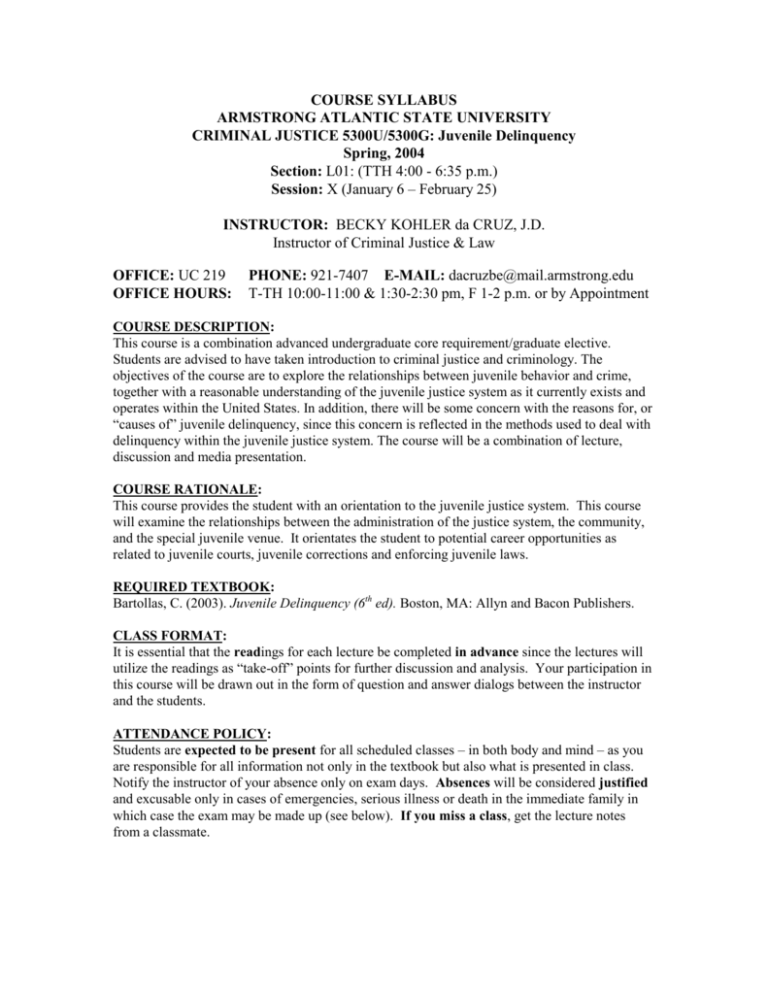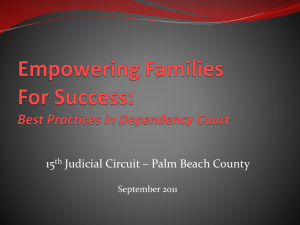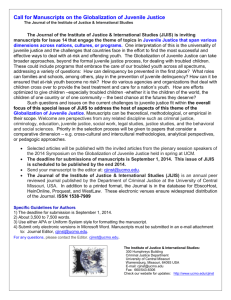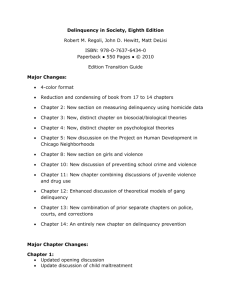crju 5300 - juvenile delinquency - Armstrong Atlantic State University
advertisement

COURSE SYLLABUS ARMSTRONG ATLANTIC STATE UNIVERSITY CRIMINAL JUSTICE 5300U/5300G: Juvenile Delinquency Spring, 2004 Section: L01: (TTH 4:00 - 6:35 p.m.) Session: X (January 6 – February 25) INSTRUCTOR: BECKY KOHLER da CRUZ, J.D. Instructor of Criminal Justice & Law OFFICE: UC 219 OFFICE HOURS: PHONE: 921-7407 E-MAIL: dacruzbe@mail.armstrong.edu T-TH 10:00-11:00 & 1:30-2:30 pm, F 1-2 p.m. or by Appointment COURSE DESCRIPTION: This course is a combination advanced undergraduate core requirement/graduate elective. Students are advised to have taken introduction to criminal justice and criminology. The objectives of the course are to explore the relationships between juvenile behavior and crime, together with a reasonable understanding of the juvenile justice system as it currently exists and operates within the United States. In addition, there will be some concern with the reasons for, or “causes of” juvenile delinquency, since this concern is reflected in the methods used to deal with delinquency within the juvenile justice system. The course will be a combination of lecture, discussion and media presentation. COURSE RATIONALE: This course provides the student with an orientation to the juvenile justice system. This course will examine the relationships between the administration of the justice system, the community, and the special juvenile venue. It orientates the student to potential career opportunities as related to juvenile courts, juvenile corrections and enforcing juvenile laws. REQUIRED TEXTBOOK: Bartollas, C. (2003). Juvenile Delinquency (6th ed). Boston, MA: Allyn and Bacon Publishers. CLASS FORMAT: It is essential that the readings for each lecture be completed in advance since the lectures will utilize the readings as “take-off” points for further discussion and analysis. Your participation in this course will be drawn out in the form of question and answer dialogs between the instructor and the students. ATTENDANCE POLICY: Students are expected to be present for all scheduled classes – in both body and mind – as you are responsible for all information not only in the textbook but also what is presented in class. Notify the instructor of your absence only on exam days. Absences will be considered justified and excusable only in cases of emergencies, serious illness or death in the immediate family in which case the exam may be made up (see below). If you miss a class, get the lecture notes from a classmate. CLASS CONDUCT: Students are expected to treat others with respect and dignity at all times. Any behavior, which is disruptive to the learning environment, is strictly prohibited. Beepers and cell phones disrupt the class, they need to be operated in silent mode or turned off. If you are disrupting the lecture, you will be removed from the classroom. LECTURE TOPICS AND READING ASSIGNMENTS: PART I: THE NATURE, EXTENT AND CAUSES OF DELINQUENCY Weeks #1 & 2 Jan. 6th & 8th Jan. 13th & 15th Introduction to the Course; Overview: Adolescence and Delinquency, The Juvenile Justice Process; Due Process Issues Bartollas Chapters 1 and 13 + Lecture Material The Measurement and Nature of Delinquency Bartollas: Chapter 2 + Lecture Material Weeks #3 & 4 Individual Causes of Delinquency: Classical/Positive Schools Jan. 20th & 22nd of Criminality; Contemporary Approaches to Juvenile Delinquency Jan. 27th & 29th Bartollas: Chapter 3 + Lecture Material Social Structure Theories: Social Disorganization; Strain; Cultural Deviance; and, Social Stratification and Delinquency. Bartollas: Chapter 4 + Lecture Material Social Process Theories: Differential Association; Delinquency and Drift; and, Control Theories of Reckless and Hirschi Bartollas: Chapter 5 + Lecture Material Social Reaction Theories of Delinquency Bartollas: Chapter 6 + Lecture Material January 29th Exam #1 PART II: Environmental Influence; Prevention, Diversion & Treatment; Social Control Week #5: Feb. 3rd & 5th The Family/School and Delinquency Bartollas: Chapters 8 and 9 + Lecture Material Gang Delinquency and Drug Issues Bartollas: Chapters 10 and 11 + Lecture Material The Police and Juveniles Bartollas: Chapter 14 + Lecture Material Weeks #6 & 7 Delinquency Prevention, Diversion and Treatment Feb. 10th & 12th Bartollas: Chapter 12 + Lecture Material Feb. 17th & 19th The Juvenile Court/Court Process Bartollas: Chapter 15 + Lecture Material Community Based Corrections for Juvenile Offenders Bartollas: Chapter 16 + Lecture Material Institutions for Juvenile Offenders Bartollas: Chapter 17 + Lecture Material *NOTE: Papers Due Thursday, February 19th! Week #8 Clean-up and Review Feb. 24th Exam #2 NOTE: This calendar is for guideline purposes only. It is subject to change. EVALUATION METHODS: For Undergraduates: 1. A midterm and a final exam. 2. One (1) paper. FINAL GRADE STANDARDS: For Undergraduates: Exam #1. . . . . . . . . . . . . . 100 points Final Exam. . . . . . . . . . . . 100 points 1 Paper . . . . . . . . . . . . . . . 50 points 250 points For Graduates: 1. A midterm and a final exam. 2. One (1) paper. 3. Book review. For Graduates: Exam #1. . . . . . . . . . . . . . 100 points Final Exam. . . . . . . . . . . . 100 points 1 Paper . . . . . . . . . . . . . . . 50 points Book Review . . . . . . . . . . 100 points 350 points You can earn a maximum of two hundred fifty (250) points for undergraduates and three hundred fifty (350) points for graduates in this course. The approximate letter and numerical equivalents are as follows: Undergraduate Graduate Grade Points Points Percent A 250-225 350-315 90-100% B 225-200 315-280 80-90% C 200-175 280-245 70-80% D 175-150 245-210 60-70% F 150-0 210-0 below 60% EXAMS: There will be two examinations during the session. Each exam will be non-cumulative; that is, it will only cover class materials and the reading assignments from the date of the last exam. The exams will consist of multiple choice, true/false or short answer, and an essay question. PAPER (Undergraduate & Graduate): An (8 page minimum) double-spaced, TYPED original review paper will be required. Each student will select a recent article from an acceptable criminal or juvenile justice journal and provide a written critique of the article. Grading will include an assessment of the student’s understanding of the materials, the adequacy of the critique, and the logical quality of the written argument. Popular magazines or non-academic materials are not acceptable sources: IF IN DOUBT ABOUT THE ACCEPTABILITY OF YOUR SOURCE, SEE THE INSTRUCTOR. A copy of the journal article must accompany the final paper. BOOK REVIEW (Graduate Students Only): Graduate students will also review a book of their choice (in consultation with the instructor) on an issue(s) relating to class material. Reviews should be in-depth, thoughtful papers, approximately 10 pages in length, typed, and double-spaced. Writing style and referencing should adhere to scholarly guidelines. Book reviews should consist of an introduction, summary of the book, critique of the book, and should answer two questions: “How does this book ‘fit’ with other readings on the same topic?” and “How does this book contribute to the issue of juvenile delinquency?” Application of the writings in the Bartollas text are expected. This project is due on Thursday, Feb. 19th. STANDARDS OF HONESTY: The college experience is founded on the concepts of honesty and integrity. Dishonesty, cheating, and plagiarism will not be tolerated in this course. Plagiarism is representing someone else’s work as your own. It includes quoting or paraphrasing a secondary source without citing that source, or copying, buying, or stealing written work from another person or another source. All class writings must be a student’s own original work, created this semester for this particular course. Remember, plagiarism is not only immoral- it is illegal. Students who commit plagiarism or who cheat on an examination will receive a zero (0) for that work. If cheating and plagiarism continue, the student will receive a failing grade in the course. Such an offense will also become a matter of your academic record. MAKE-UP POLICY: Students are expected to take exams and turn in their assignments on their assigned dates. A Late paper WILL NOT be accepted for any reason. If you fail to take an exam on the designated date, your grade on the make-up exam will be reduced by 10 percent (1 letter grade). A make-up exam will ONLY be given when advance notice is provided to the instructor by the student who has good reason for not taking the exam on the dedicated date or if the student has an extreme emergency. In no event will a make-up exam be given 1 week after the date in which it was given or upon the student’s return from the emergency. EXTRA CREDIT POLICY: Do not count on any extra credit in this course. You are expected to learn the core material as assigned. IF any extra credit is offered during the semester, it must be completed on or before the last day of class - it will not be accepted during exam week. CRJU 5300U/5300G: JUVENILE DELINIQUENCY Spring Semester, 2004: Liberty Center, Session X REQUIREMENTS FOR THE REVIEW PAPER I. Content of the Paper A. As stated in the syllabus, the paper must discuss and summarize a research article (within the purview of juvenile delinquency and/or the juvenile justice system) from a criminal justice journal. It must: (1) Analyze and Discuss the program/service, etc. under scrutiny; (2) Summarize the research/content of the article. Indicate what the research determined about the program/service being evaluated, and, where possible, relate the findings to the text. (3) Provide your analysis and/or evaluation of the research. State what the conclusions might mean to or for the juvenile justice system. The instructor is looking for what you have learned about a juvenile justice system agency or service. The most common mistakes are (a) selecting a poor article, (b) just summarizing the article and not analyzing it or discussing your views, (c) failing to relate the article to larger (broader) juvenile justice issues as found in the text. Broader issues are how the research might yield a different approach to managing offenders, usefulness of various alternatives (example—community corrections), different approaches to agency management, etc. B. II. Format and Submission of the Paper A. You should use a cover page, which does not count as part of the 8 page minimum for the paper. Your name, title of the article, course name and date should appear on the cover page. The paper should be stapled together, please do not use a folder, cover, binder, etc. B. Journal articles selected will be a minimum of 10 pages in length, inclusive of pictures, graphs, tables, etc. You may reference other sources in your paper. With rare exception, articles prior to 2002 will not be accepted. C. References to the journal article reviewed are not necessary throughout the paper, although you must use cites when you quote exactly from the paper (e.g., Williams, p 4) although no more than three direct quotes will be allowed in your paper. Page references to other sources must be in an approved style, (I don’t care which one, as long as it is consistent throughout the paper). Full references should be included on the last page of your paper, which does not count as part of the 8 page minimum. D. A COPY OF THE ARTICLE MUST ACCOMPANY THE PAPER WHEN SUBMITTED. Papers submitted without a copy of the journal article will be penalized up to 20 points.





